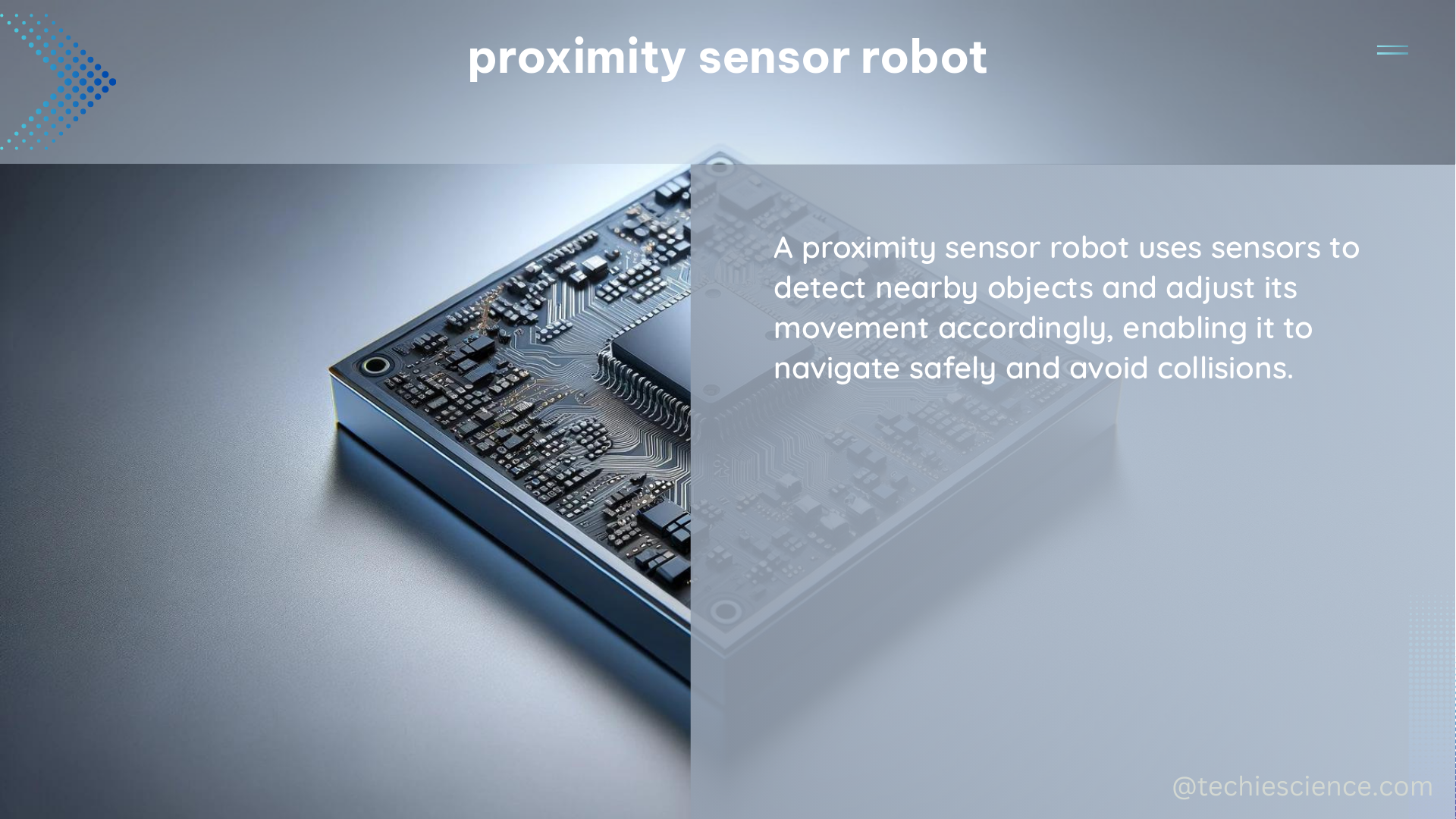Proximity sensor robots are a type of autonomous mobile robot that utilize various sensors to detect and measure the distance or proximity of objects in their surrounding environment. These robots are designed to navigate through complex spaces, avoid obstacles, and perform a wide range of tasks with precision and efficiency.
Understanding Proximity Sensors
Proximity sensors are the core components of these robots, and they come in different types, including:
- Ultrasonic Sensors: These sensors emit high-frequency sound waves and measure the time it takes for the echo to return, allowing them to calculate the distance to an object.
- Typical operating range: 2 cm to 4 m
- Accuracy: ±1% of the measured distance
-
Update rate: 20-50 Hz
-
Infrared (IR) Sensors: These sensors detect the presence of objects by measuring the amount of infrared radiation they emit or reflect.
- Typical operating range: 2 cm to 80 cm
- Accuracy: ±2% of the measured distance
-
Update rate: 50-100 Hz
-
Laser-based Sensors: These sensors use laser light to measure the distance to an object with high precision.
- Typical operating range: 0.1 m to 100 m
- Accuracy: ±0.1% of the measured distance
- Update rate: 100-1000 Hz
The choice of proximity sensor depends on the specific requirements of the application, such as the desired range, accuracy, and update rate.
Sensor Integration and Data Processing

Proximity sensor robots typically integrate multiple sensors to enhance their perception and decision-making capabilities. These sensors are connected to a central processing unit, such as a microcontroller or a single-board computer, which processes the sensor data and generates appropriate control signals for the robot’s actuators.
The sensor data is often fused using techniques like Kalman filtering or sensor fusion algorithms to improve the reliability and accuracy of the robot’s perception. This data is then used for tasks such as:
- Obstacle detection and avoidance
- Mapping and localization
- Object tracking and recognition
- Autonomous navigation and path planning
Technical Specifications and Considerations
When designing a proximity sensor robot, several technical specifications and considerations must be taken into account, including:
-
Sensor Range and Accuracy: The sensors must have the appropriate range and accuracy to suit the robot’s operating environment and tasks.
-
Field of View: The sensors should provide a wide enough field of view to ensure comprehensive coverage of the robot’s surroundings.
-
Update Rate: The sensors should have a high enough update rate to enable the robot to respond quickly to changes in its environment.
-
Power Consumption: The robot’s power consumption, including the sensors, must be optimized to ensure efficient operation and extended battery life.
-
Processing Capabilities: The robot’s onboard processing unit must have sufficient computational power to handle the sensor data processing and decision-making tasks in real-time.
-
Communication Interfaces: The robot should have the necessary communication interfaces, such as Bluetooth, Wi-Fi, or Ethernet, to enable remote control, data transmission, and integration with other systems.
-
Size and Weight: The overall size and weight of the robot must be carefully considered to ensure maneuverability, portability, and ease of deployment.
Measuring the Value of Proximity Sensor Robots
Evaluating the performance and value of a proximity sensor robot project can be done using various metrics, such as:
-
Cost Savings: Quantify the cost savings achieved through automation, reduced labor, or improved efficiency.
-
Performance Improvements: Measure the improvements in task completion time, accuracy, or throughput.
-
Safety and Health Benefits: Assess the reduction in workplace accidents or injuries due to the robot’s ability to detect and avoid hazards.
-
Operational Efficiency: Analyze the improvements in resource utilization, energy consumption, or maintenance requirements.
-
Customer Satisfaction: Gather feedback from clients or end-users to gauge the overall satisfaction with the robot’s performance and usability.
Data collection methods for these metrics can include sensors, surveys, interviews, and operational reports. The data can then be analyzed using statistical, mathematical, or computational techniques to extract meaningful insights and patterns.
Conclusion
Proximity sensor robots are a powerful technology that can enhance various applications, from industrial automation to assistive robotics. By understanding the different types of proximity sensors, their integration, and the technical considerations involved, you can design and implement effective proximity sensor robot solutions that deliver tangible value and improve overall performance. Remember to carefully evaluate the project’s success using a range of quantifiable metrics to ensure the robot’s optimal performance and alignment with your specific goals and objectives.
References:
– Corners and columns are detected by the laser sensor and described qualitatively as relevant landmarks. Images taken by the robot camera are described qualitatively. (n.d.). ScienceDirect. Retrieved May 10, 2024, from https://www.sciencedirect.com/science/article/abs/pii/S0167865512002681
– Quantitative Performance Metrics for Mobile Robots Navigation. (n.d.). ResearchGate. Retrieved May 10, 2024, from https://www.researchgate.net/publication/221908028_Quantitative_Performance_Metrics_for_Mobile_Robots_Navigation
– How do you measure the value of robotics projects for clients? (2023, August 21). LinkedIn. Retrieved May 10, 2024, from https://www.linkedin.com/advice/0/how-do-you-measure-value-robotics-projects-clients-skills-robotics
– Sensors in autonomous mobile robots for localization and navigation. (2019, February 8). TechTarget. Retrieved May 10, 2024, from https://www.techtarget.com/iotagenda/blog/IoT-Agenda/Sensors-in-autonomous-mobile-robots-for-localization-and-navigation

The lambdageeks.com Core SME Team is a group of experienced subject matter experts from diverse scientific and technical fields including Physics, Chemistry, Technology,Electronics & Electrical Engineering, Automotive, Mechanical Engineering. Our team collaborates to create high-quality, well-researched articles on a wide range of science and technology topics for the lambdageeks.com website.
All Our Senior SME are having more than 7 Years of experience in the respective fields . They are either Working Industry Professionals or assocaited With different Universities. Refer Our Authors Page to get to know About our Core SMEs.